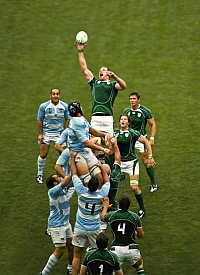 Computer algorithms developed by Ecole Polytechnique Fédérale de Lausanne (EPFL) in Switzerland make it possible to visually track individual players in action on sports teams. The technology developers, from EPFL’s Computer Vision Laboratory, present their findings today at the International Conference on Computer Vision in Barcelona.
Computer algorithms developed by Ecole Polytechnique Fédérale de Lausanne (EPFL) in Switzerland make it possible to visually track individual players in action on sports teams. The technology developers, from EPFL’s Computer Vision Laboratory, present their findings today at the International Conference on Computer Vision in Barcelona.
The system can track multiple players in fast-moving sports such as basketball or rugby, without adding extra RFID chips or devices, from the time they set foot on the field, pitch, or court. The system consists of eight cameras — two on each side of the field or court, two that film from above, and two that zoom — and three algorithms. After an increment of action, the system automatically reattributes the jersey or uniform number to each player.
The three algorithms were developed by the Computer Vision Lab’s Jerôme Berclaz, Horesh Ben Shitrit, Engin Turetken, and Pascal Fua with François Fleuret from the Idiap Research Institute in Martigny, Switzerland. One algorithm detects individuals at a specific moment in time, independently of where they were the moment before or after. To do this, the algorithm divides the playing area into small 25 centimeter squares, removes the background in all the images simultaneously, and deduces the probability of the presence of a player in each of the small squares.
The other two algorithms connect the results obtained for each moment to establish individual trajectories. All three routines use global optimization methods that result in what the developers call a robust and reliable system. The lab is now making final adjustments that will allow television cameras to provide direct input to the system, making it more marketable to international competitions.
The developers see applications for the technology beyond sports. One potential use is for public safety, such as tracking pedestrians in a busy intersection. Another potential application is for tracking shopping behavior of individual customers in stores. Doctoral student Horesh Ben Shitrit tells more about and demonstrates the system in the following video.
Read more: Caltech Develops High Rez, High Speed, High Depth 3D Imaging
Photo: Paolo Camera/Flickr
* * *

 RSS - Posts
RSS - Posts
You must be logged in to post a comment.